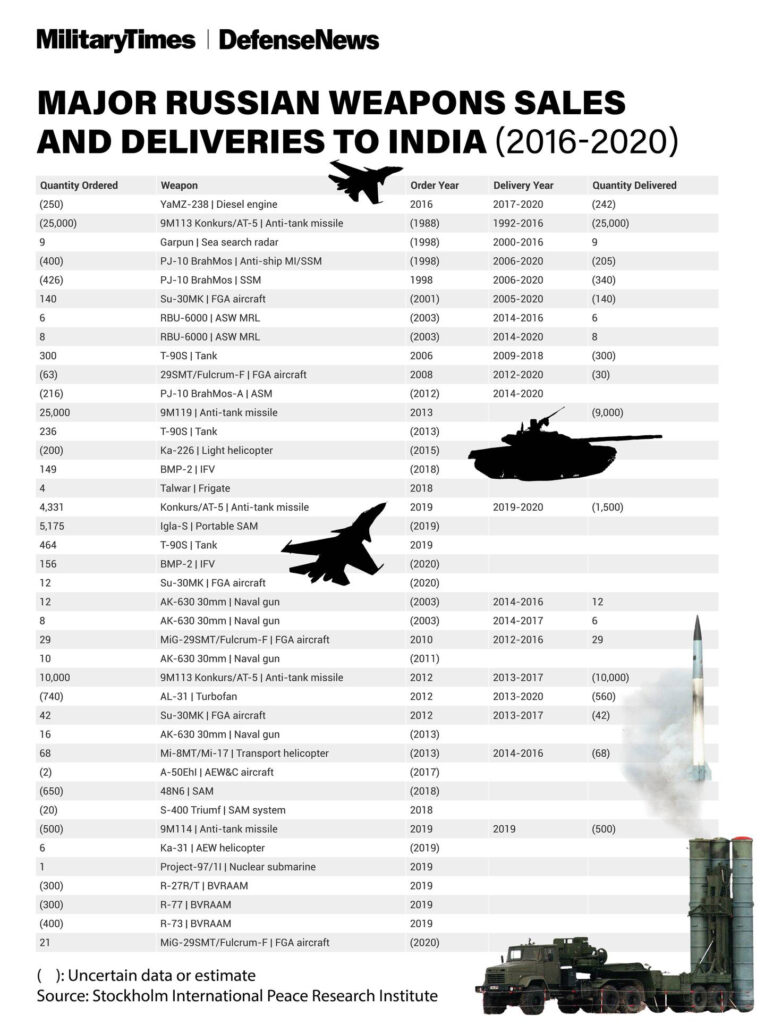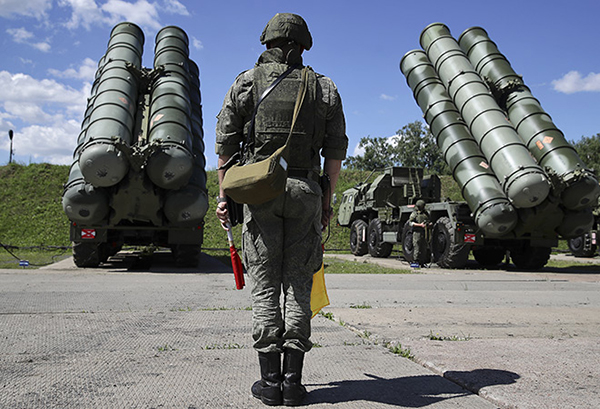US wants to wean away India
Until recently, India bought almost all its frontline weaponry from Russia. Researchers at the Stimson Center calculate that, about 85% of India’s major weapons are overwhelmingly of Russian origin. Moreover, the Stockholm International Peace Research Institute (SIPRI) says that “new orders [from India] for a variety of Russian arms in 2019–20… will probably lead to an increase in Russian arms exports in the coming five years.”
The Indian government’s unwillingness to condemn Russia forcefully for its invasion of Ukraine seems to have raised the question amongst US leaders – how to wean the Indian military off its dependence on Russian arms. The fact is that, like all developing nations, India confronts an impossible trinity when it comes to weapons programs: It cannot simultaneously achieve autonomy, affordability and quality.
New Delhi has long talked of diversifying the suppliers to its huge armed forces, and even making more equipment at home, objectives that have taken on new urgency since Russia’s invasion.
India has identified $324 million worth of defence equipment it wants domestic firms to make this year, and avoid buying abroad, according to an online platform where the defence ministry lists its needs.
Defence transition is always a slow evolutionary process. Suppliers cannot be switched overnight.
Russian Imports
India is the world’s largest buyer of Russian weapons, although it has scaled back that relationship of late. Russia has historically supplied the majority of India’s military hardware, including fighter jets and missiles, as well as almost all its tanks and helicopters. Modi’s government has told the US the alternatives to moving away completely from Russian weapons imports are too expensive.


Over the past decade, India has bought more than $4 billion worth of military equipment from the US and more than $25 billion from Russia, according to SIPRI, which collects data on arms transfers. India’s dependence on Russia for weapons against neighbors China and Pakistan is a big reason Modi’s government has avoided criticizing Russian President Vladimir Putin over the war in Ukraine. As the US, Europe, Australia and Japan piled economic sanctions on Russia, India has held off and instead continued imports of discounted Russian oil.
Russia woos India
On the other hand, Russia’s foreign minister Sergey Lavrov said, on 20 April, that Russia could give India any defence platform and weaponry it wants. He also termed the transfer of defence technology to India as “unprecedented” among the foreign nations that India has ties with.
Asked about the Sino-Indian border dispute, he said: “We welcome the discussions between India and China”, adding that Russia wanted to further strengthen the trilateral Russia-India-China (RIC) format that he said was envisaged by Moscow way back in 1996 and made a reality.
Affordability and Autonomy
Shifting toward buying more Western weapons systems and lessening its dependence on Russia, for instance, would bolster India’s autonomy. But the country would have to sacrifice affordability, meaning it wouldn’t be able to buy as much. India is spending $5.5 billion on the Russian S-400 surface-to-air missile platform. The U.S.-made Terminal High-Altitude Area Defense system costs about six times that much and isn’t even as versatile.
India is highly unlikely to want to rely on anyone else for essential defense requirements. In its last full-scale war with Pakistan, in 1971, India found itself constantly short of artillery shells and had to secretly import mortars from Israel. Insufficient weapons on hand represent a loss of autonomy that no Indian government could possibly countenance.
Self Reliance
For decades, India has tried to establish a local defense industry, building its own battle tank and jet. The Arjun, the Indian Army complains, can not be part of any battle plans on the canal-heavy, militarized border with Pakistan. It weighs almost 70 tons and would collapse most bridges in the Punjab. By contrast, Russia’s T-90 tank weighs less than 50 tons.
The Indian Air Force has a long list of reasons why the Tejas is not good enough: Its payload is smaller than the F-16’s, the plane takes too long to service and so on.
Indigenization offers affordability and autonomy, at the cost of quality. The Indian state’s toxic relationship with the private sector is one of the biggest obstacles to indigenizing weapons production. But if Indian leaders want a reliable and affordable pipeline of weapons of decent quality that arrive quickly enough to deter an aggressive China, they are going to have to fund domestic defence companies, increase military budgets, and field less powerful weapons until they can develop better ones.
US Preparing Package
The US and its allies have sought to woo Modi’s government as a key security partner – against China in the Indo-Pacific region. Links between the US and India have steadily deepened over the past two decades, with the two sides reaching agreements that allow for more interoperability between their military platforms.
The US is preparing a military aid package for India to deepen security ties and reduce its dependence on Russian weapons. The package under consideration would include foreign military financing of as much as $500 million, which would make India one of the largest recipients of such aid behind Israel and Egypt. It’s unclear when the deal would be announced, or what weapons would be included.
Fixing the problem is going to take time. And it won’t happen unless the Indian defense establishment is willing to make some hard choices. The effort is part of a much larger initiative by President Joe Biden’s administration to court India as a long-term security partner, despite its reluctance to criticize Russia for its invasion of Ukraine.
Washington wants to be seen as a reliable partner for India across the board, and the administration is working with other nations including France to make sure Prime Minister Narendra Modi’s government has the equipment it needs. While India is already diversifying its military platforms away from Russia, the US wants to help make that happen faster.
The major challenge remains how to provide India major platforms like fighter jets, naval ships and battle tanks. The administration is looking for a breakthrough in one of these areas. The financing package being discussed would do little to make those types of systems — which can cost billions or tens of billions of dollars — more affordable, but it would be a significant symbolic sign of support. Still, it remains to be seen how far India will go in accepting US military assistance.
The Biden administration has signaled that it was not interested in sanctioning New Delhi over its recent decision to buy the S-400 missile defense system from Russia. Turkey’s purchase of the same system deeply damaged US ties with the NATO ally.

















